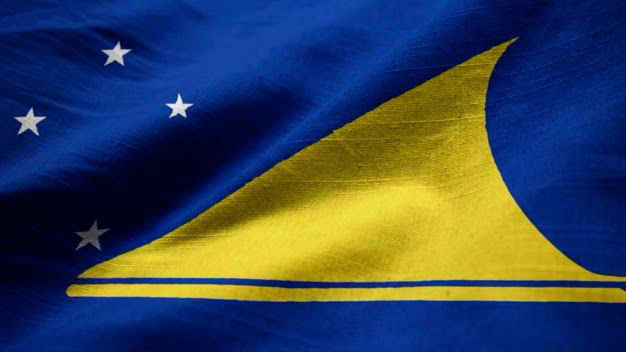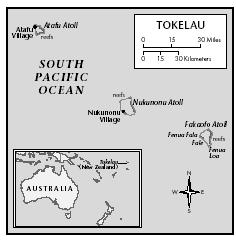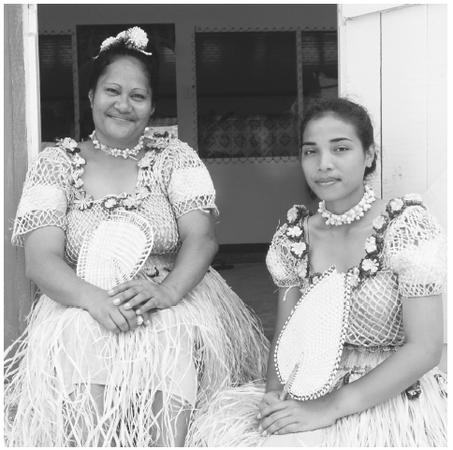Culture of Tokelau

Culture Name
Tokelauan
Orientation
Identification. "Tokelau" means "north-northeast." Its people also identify themselves by their atoll villages: Atafu, Fakaofo, and Nukunonu.
Location and Geography. Three unbroken rings of coral with a combined land area of somewhat over four square miles (ten square kilometers) lie along a 93 mile (150 kilometers) northwest– southeast axis, separated from each other by 37 to 56 miles (60 to 90 kilometers) of open sea.Demography. The population is about 1,700. An additional estimated five thousand reside overseas, mainly in New Zealand.
Linguistic Affiliation. Tokelauan is a Polynesian language. Older people are bilingual in Samoan, which was introduced with Christianity in the 1860s; younger people are more apt to be bilingual in English through their schooling.
Symbolism. Homeland atolls are the preeminent symbols, denoting both place and ancestry.
History and Ethnic Relations
Emergence of the Nation and National Identity. As a culturally distinctive dependency of New Zealand, Tokelau is a nation. After sixty years as a British protectorate and then a colony ruled with "benign neglect," in 1948 Tokelau became "a part of New Zealand" and its people became New Zealand citizens. Most people want to retain that status, which combines considerable local political autonomy with substantial external support.
Ethnic Relations. Virtually all residents are of Tokelauan ancestry. In New Zealand, Tokelauans are a minority population among other Pacific Islanders, Maori, and persons of Asian and European ancestry. Many conscientiously maintain aspects of their culture.
Urbanism, Architecture, and the Use of Space
The villages are densely peopled and like small rural towns in character. Public buildings under the aegis of the village are the meeting house and the church. Public amenities under the control of the administration/public service are the dispensary/hospital, school, and administration compound that houses the communications center (formerly the two-way radio), the village cooperative store, and offices for administrative and elected officers. Dwelling houses are rectangular single-room structures on raised coral-filled foundations and aligned with the straight heavily traveled footpaths. Until the 1970s, the houses were open constructions of local timber and pandanus-leave thatch, with plaited coconut frond blinds that could be lowered against wind and rain. Now the houses are more closed, built of imported lumber, concrete, and corrugated iron, sometimes with louvered glass windows. They are still, however, carpeted with mats plaited from pandanus and/or coconut leaves, upon which the occupants sit and lounge. Other furnishings are rolled-up sleeping mats, locked wooden boxes containing clothing and other personal belongings, and miscellaneous chairs, tables, and bedsteads. Separate cookhouses, still constructed of local materials, may be adjacent to, or more likely, distant from dwelling houses.
Food and Economy
Food in Daily Life. Fish and coconuts are abundant; other local foods are seasonal or scarce. Stores stock imported food, mainly rice, flour, and sugar.
Basic Economy. Traditional economic activities center on the land, reef, lagoon, and sea. Fishing is

Tokelau
strictly a subsistence activity, pursued with ingenuity backed by extensive knowledge. Coconuts rarely are harvested for uses other than subsistence since public service employment became the main source of cash. Handicrafts are more often produced as gifts than for cash.
Land Tenure and Property. Aside from a small portion of land used for communal purposes, all land is held by cognatic kin groups and managed by persons with recognized positions within those groups. Village houses are occupied and managed by kin group women; men manage and harvest plantation lands. Virtually everyone has rights to land and to a share of the produce from the land. Most people are members of more than one kin group and many receive produce from four or more.
Commercial Activities. All entrepreneurial activities are closely scrutinized by the Councils in each village.
Division of Labor. A major division exists between salaried public service employees who have job qualifications and wage-earning public service employees who do not. The distinction between paid and unpaid work has been partially eroded by village management of aid projects, for which all village workers are paid. Age determines who does what, who directs, and who labors.
Social Stratification
Classes and Castes. An egalitarian ethic overrides differentials in wealth among a growing elite whose education and experience qualify them for better-paid employment or positions. They contribute generously to village and family enterprises and avoid ostentatious displays of affluence.
Political Life
Government. The New Zealand Ministry of Foreign Affairs administers Tokelau, delegating certain powers to the three village-elected Faipule, who rotate as "head" of Tokelau during their three-year terms.
Leadership and Political Officials. Councils of elderly men and/or representatives of kin groups control the villages and direct village activities through the elected Pulenuku ("mayor").
Social Problems and Control. Persons are reprimanded in communal venues by their elders and peers for minor misdemeanors and are brought before local courts for more serious ones.
Social Welfare and Change Programs
Development programs proliferate, supported by New Zealand and by international, regional, and other aid.
Nongovernmental Organizations and Other Associations
Organizations of able-bodied men, adult women, and competing "sides" are long-standing village institutions, as are several church associations. Clubs and youth groups are less permanent.
Gender Roles and Statuses
Division of Labor by Gender. The adage that men "go"—fishing and harvesting—and women "stay"—managing the family—has been compromised by widespread public service employment. Both men and women work in skilled jobs; most unskilled workers are men.
Relative Status of Women and Men. Complementary equity predicated on sister-brother relationships has been compromised by Christian ideology and money.

Performers from the Tokelau Islands wear traditional dress as they attend the South Pacific Arts Festival.
Marriage, Family, and Kinship
Marriage. Virtually all residents enter into sanctified, lifelong monogamous unions. Individual choice is constrained by kin group exogamy.
Domestic Unit. The pattern is an uxorilocal, often expanded nuclear family, in line with the adage that women "stay" and men "go."
Inheritance. All offspring inherit rights from both parents.
Kin Groups. Members of each cognatic kin group reside throughout the village and interact regularly.
Socialization
Child Rearing and Education. Infant care is indulgent. Children are closely disciplined and precisely instructed in increasingly complex tasks.
Higher Education. All children attend village primary and secondary schools; many continue their schooling abroad.
Etiquette
Deference and obedience to one's elders and restraint between cross-sex siblings is expected. Physical aggression is abhorred.
Religion
Religious Beliefs. Protestant and Catholic congregations practice a fundamentalist, puritanical form of Christianity.
Religious Practitioners. Protestant pastors, deacons, and lay preachers and Catholic priests, catechists, and elders direct their respective congregations.
Rituals and Holy Places. Churches are cherished sites with frequent masses and services.
Death and the Afterlife. A short wake, church service, and burial are followed by evenings of mourning and ended by a feast. Unusual events and encounters may be attributed to ghost spirits. The dead are fondly remembered.
Medicine and Health Care
Western curative and preventive medicine has long been available. The hospital is normally the first resort. Local therapists mainly use massage.
Secular Celebrations
Numerous commemorative days and other celebrations feature feasts, competitions, parades, and entertainment.
The Arts and Humanities
Literature. Oral narratives may be fictional stories or recountings of the past.
Graphic Arts. Women work in fiber, and men work in wood.
Performance Arts. Poetry, music, and dance are combined in old and new group compositions.
Bibliography
Angelo, A. H. "Tokelau." In M. A. Ntumy, ed., South Pacific Legal Systems , 1993.
Angelo, T. "The Last of the Island Territories? The Evolving Constitutional Relationship with Tokelau." Stout Centre Journal , 1996.
Hooper, Antony. "The MIRAB transition in Fakaofo, Tokelau." Pacific Viewpoint 34 (2): 241–264, 1997.
Huntsman, J., and A. Hooper. "Male and Female in Tokelau Culture." Journal of the Polynesian Society 84: 415–430, 1975.
——. Tokelau: A Historical Ethnography , 1996.
Matagi Tokelau. Tokelau History and Traditions , 1991.
Simona, R. Tokelau Dictionary , 1986.
Wessen, A. F., A. Hooper, J. Huntsman, I. A. M. Prior, and C. E. Salmond, eds. Migration and Health in a Small Society: The Case of Tokelau , 1992.
